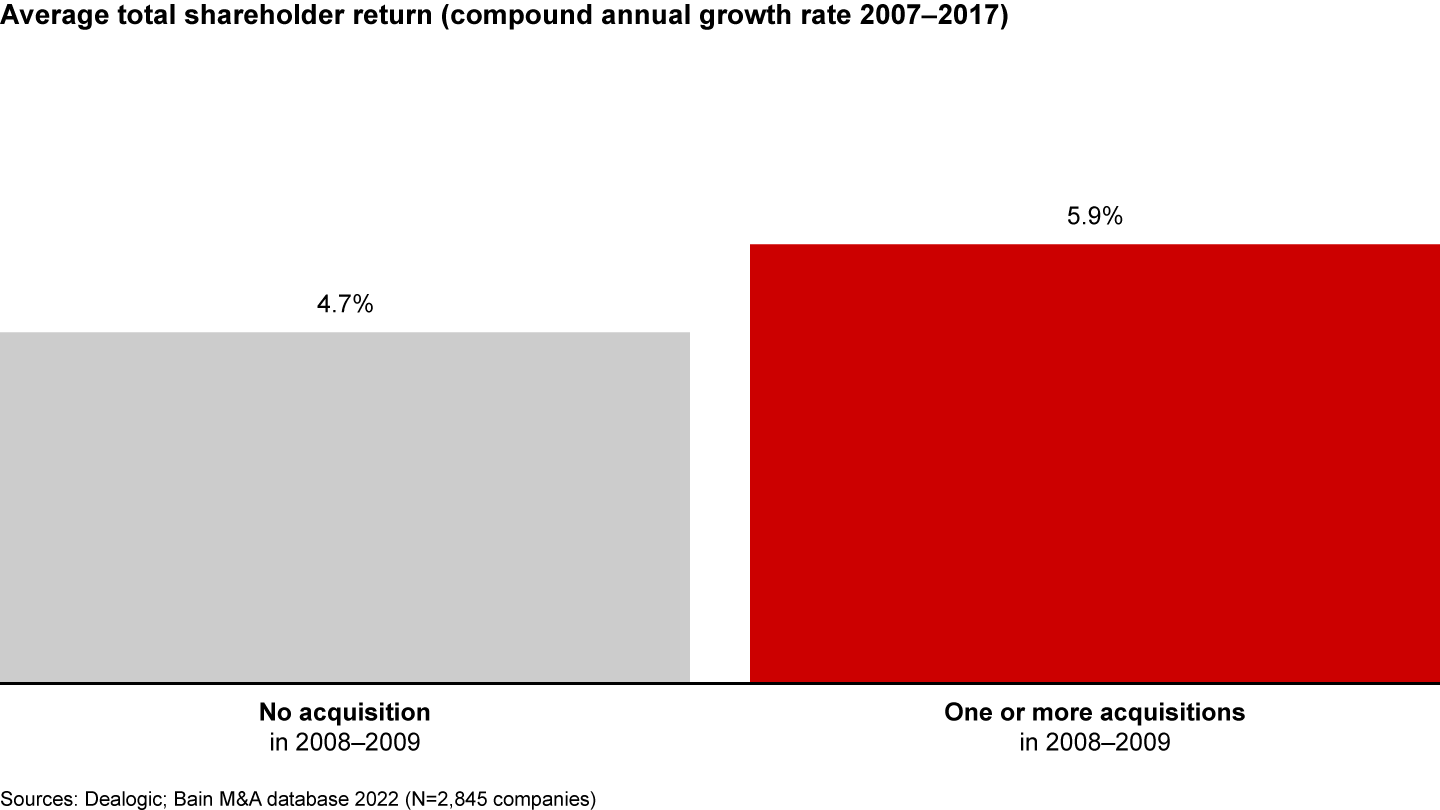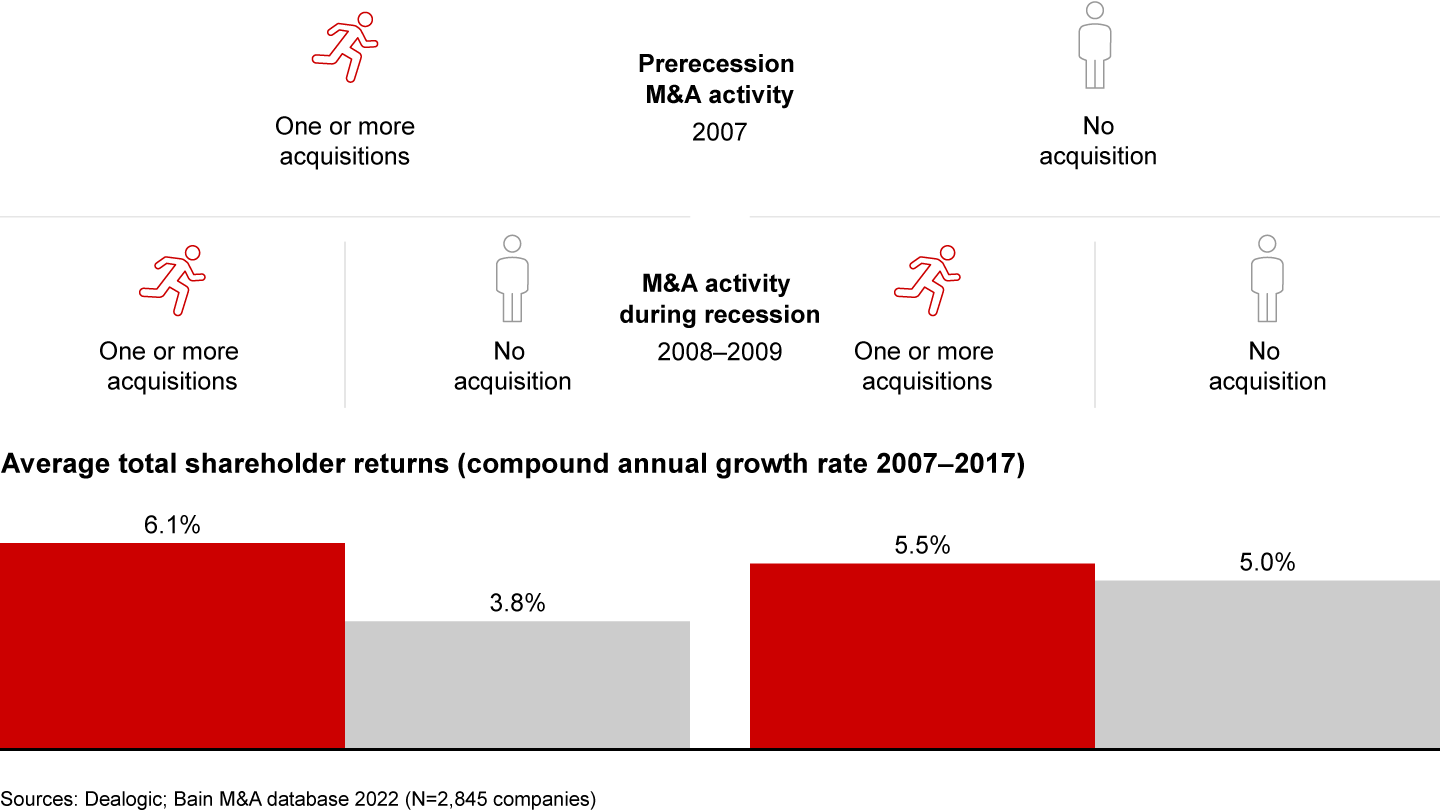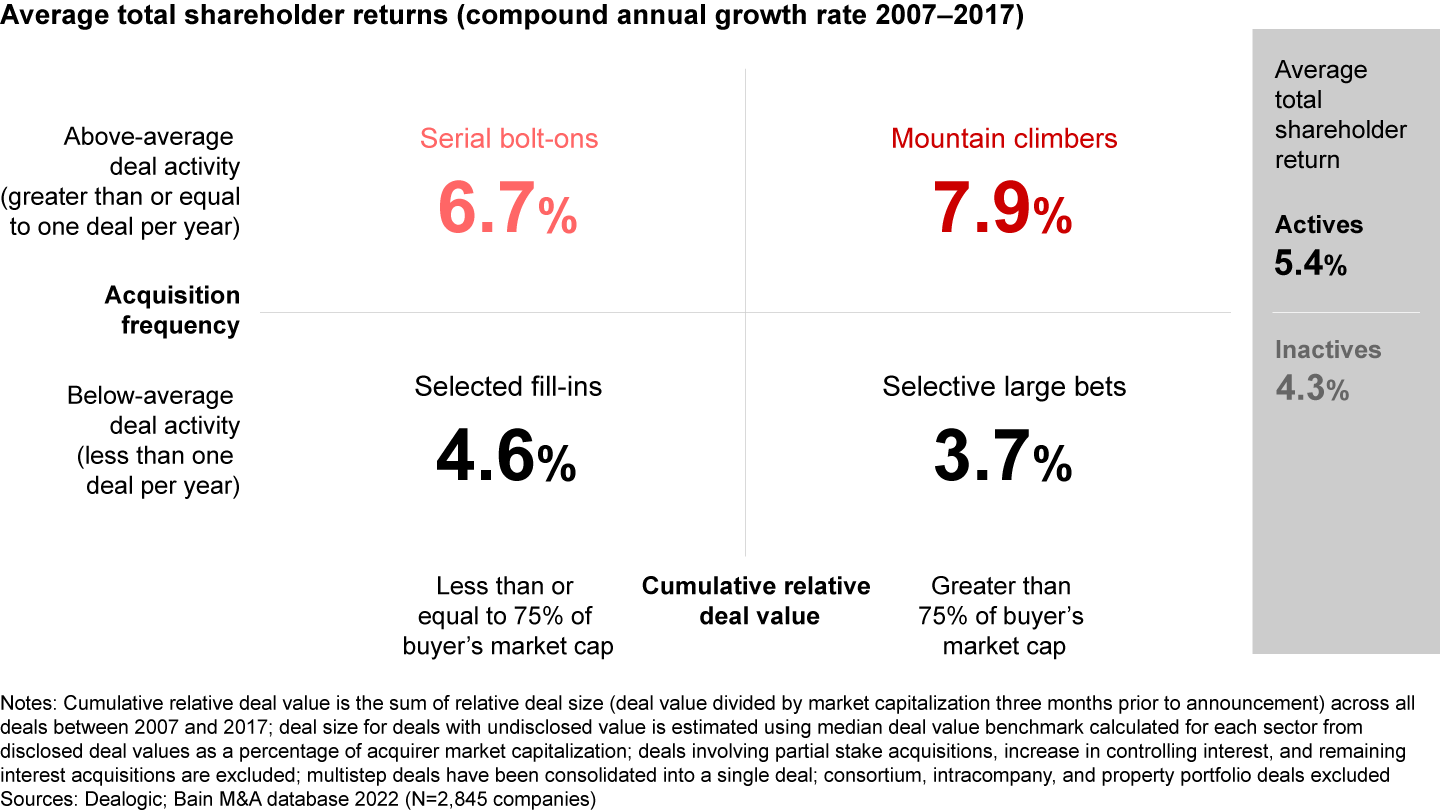M&A Report
 }
}
At a Glance
- Many companies are wary about acquiring during this downturn, but 2008–2009’s active acquirers outperformed their less-active competitors over the long haul.
- More specifically, they achieved a greater compounded average annual total shareholder return than that of their less-active competitors.
- Being an active acquirer is not an end in itself.
- The most important objective is to execute the strategy—be it strengthening the core and increasing scale or creating strategic options via a scope deal.
This article is part of Bain's 2023 M&A Report.
Bain’s bedrock beliefs on how to create value from M&A rest on fundamental truths that have stood the test of time: If you want to be successful at M&A, develop a repeatable model. Do it often, learn from your mistakes, and make it a material part of your business. Done right, it will generate higher shareholder returns.
This year, we look back at the global financial crisis of 2008–2009 and ask what lessons can be learned from different M&A behavior during times of turbulence.
Stay in the game through tough times to come out ahead
We assessed the returns to shareholders of different M&A strategies employed by a universe of 2,845 publicly traded companies from around the world for the period between 2007 and 2017.
In 2007, worldwide deals surpassed 40,000 for the first time; their cumulative value hit $4.6 trillion, 40% above the dotcom peak in 2000. It seemed like the M&A party might never stop. But when the global financial crisis brought the boom to an abrupt end and most economies went into recession sometime during 2008–2009, the hangover set in. Many business leaders grew leery of any kind of dealmaking—deal volume dropped by 14% from 2007 to 2009.
The reaction was understandable, but the opportunity cost for many was huge. Companies that were active in M&A during turbulent times, the data shows, consistently outperformed those that stayed away from deals. Companies that acquired during the last economic downturn achieved an average annual total shareholder return (TSR) of 5.9% compared with 4.7% for those that did not (see Figure 1).

Of course, being an active acquirer is not an end in itself. The most important objective of M&A is to help execute a company's strategy—be it strengthening the core business and increasing scale or creating strategic options via a scope deal. During a recession, M&A also serves another purpose: creating strategic options. The post-recession landscape will be very different, and no one really knows how supply chains may change, what the financial system will look like, or to what degree consumers will have changed their spending patterns.
Being an active acquirer is not an end in itself.
Several industry-defining deals were made throughout the last economic recession. In 2008, BASF acquired Ciba for $5.4 billion in what accounted for the largest acquisition in BASF’s company history until that point, with the aim to fully integrate Ciba into BASF and a focus on realizing cost synergies initially targeted at 10% of sales (and subsequently raised). In 2009, Stanley Works—now Stanley Black & Decker—leveraged its strong M&A capability to significantly grow share by acquiring the larger Black & Decker. The merger was well-timed as the construction cycle exposure made Black & Decker vulnerable in 2009, leading to a 22% drop in revenue and a 41% drop in earnings before interest and taxes, which, in turn, lowered its valuation. Stanley was able to leverage a proven integration capability that it had built from an aggressive M&A program started in 2002 with the acquisition of 33 companies over the next several years.
Some companies used their resources to expand their strategic options through acquisitions despite the downturn. For example, Pfizer's agreement to acquire Wyeth for $68.4 billion in early 2009 bought some time for Pfizer as patents were about to expire on several of its leading medicines, and it gave Pfizer an opportunity to diversify its pharmaceuticals portfolio and expand its pipeline (with a particular focus on biopharmaceuticals and vaccines). In the second half of 2009, Disney acquired superhero stable Marvel for $4.2 billion, with the aim of putting these characters to work in its television shows, video games, theme parks, and movies.
Several industry-defining deals were made throughout the last economic recession.
Should companies adjust their M&A behavior during times of turbulence?
We have outlined the returns of different types of acquirers regarding their prerecession and recession-era M&A activity. Those companies that were active acquirers before the recession performed best by staying active—their average annual TSR was 6.1% compared with 3.8% for those that decided to move to the sidelines (see Figure 2, left). For those companies that were inactive before the recession, a change in their M&A behavior toward becoming an active acquirer resulted in an annual TSR of 5.5% compared with 5.0% for those that remained inactive (see Figure 2, right).

What can be learned from the most successful acquirers?
The core research underlying our belief in the concept of repeatable M&A (replicated multiple times over the past 20 years) shows that frequency (how many deals you do) and materiality (how much of it you do) define a lot of what differentiates M&A performance (see Figure 3). It does not take a lot of deals to become a frequent acquirer, about one per year. To be a material acquirer does require heft: 75% or more of your market cap from acquired companies over a decade. Those companies that are both frequent and material acquirers over a 10-year period—we call them “mountain climbers” (see Figure 3, top right)—create the greatest TSRs.

Consistent M&A activity over economic cycles contributes to higher TSR. This finding holds up year after year, across industries. Deal success and deal failure is more a matter of cumulative experience and capability in making a deal and less a function of standalone deal circumstances.
A big learning from our study comes from the failure of companies that are infrequent acquirers but that undertake large deals relative to their market capitalization—we refer to such companies as “selective large bets” (see Figure 3, bottom right). While we outlined above why we are encouraging M&A during turbulent times, companies that have not been doing deals to build their M&A muscle should be more cautious when the opportunity of a lifetime comes along. Among all companies studied, selective large bets are the worst performers over time as their limited acquisition experience, combined with investment in a large deal, usually results in poor deal outcomes. They generated only 3.7% in annual TSR from 2007 to 2017.

Strategische Due Diligence
Die strategische Due Diligence von Bain liefert eine faktenbasierte, strikt quantifizierte Bewertung des Übernahmekandidaten. So vermeiden wir, dass unsere Kunden böse Überraschungen erleben, und ermöglichen ihnen, frühzeitig Synergien zu erkennen. Gleichzeitig wird die gesamte Organisation beizeiten auf die Integration des übernommenen Unternehmens vorbereitet.
Similar to most things in life, you get better at what you do when you do it repeatedly. Companies that acquire frequently, “serial bolt-ons” (see Figure 3, top left), tend to outperform the average company on TSR (6.7% annual).
Mountain climbers, those companies that not only acquire frequently but that also develop the capabilities to undertake larger deals, do even better. Their 7.9% annual TSR leads the class. Investors have come to recognize this.
With the drop of M&A activity in 2022 and all the current turbulence, some executives will no doubt sit on the sidelines thinking it is safer not to play. Experience suggests that their performance will suffer accordingly. The winners will be those that stay in the game—and learn how to play it well.


